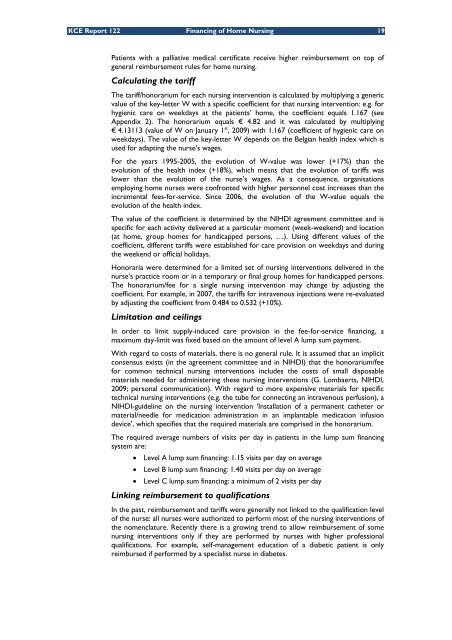Le financement des soins infirmiers à domicile en Belgique - KCE
Le financement des soins infirmiers à domicile en Belgique - KCE
Le financement des soins infirmiers à domicile en Belgique - KCE
Create successful ePaper yourself
Turn your PDF publications into a flip-book with our unique Google optimized e-Paper software.
<strong>KCE</strong> Report 122 Financing of Home Nursing 19<br />
Pati<strong>en</strong>ts with a palliative medical certificate receive higher reimbursem<strong>en</strong>t on top of<br />
g<strong>en</strong>eral reimbursem<strong>en</strong>t rules for home nursing.<br />
Calculating the tariff<br />
The tariff/honorarium for each nursing interv<strong>en</strong>tion is calculated by multiplying a g<strong>en</strong>eric<br />
value of the key-letter W with a specific coeffici<strong>en</strong>t for that nursing interv<strong>en</strong>tion: e.g. for<br />
hygi<strong>en</strong>ic care on weekdays at the pati<strong>en</strong>ts’ home, the coeffici<strong>en</strong>t equals 1.167 (see<br />
App<strong>en</strong>dix 2). The honorarium equals € 4.82 and it was calculated by multiplying<br />
€ 4.13113 (value of W on January 1 st , 2009) with 1.167 (coeffici<strong>en</strong>t of hygi<strong>en</strong>ic care on<br />
weekdays). The value of the key-letter W dep<strong>en</strong>ds on the Belgian health index which is<br />
used for adapting the nurse’s wages.<br />
For the years 1995-2005, the evolution of W-value was lower (+17%) than the<br />
evolution of the health index (+18%), which means that the evolution of tariffs was<br />
lower than the evolution of the nurse’s wages. As a consequ<strong>en</strong>ce, organisations<br />
employing home nurses were confronted with higher personnel cost increases than the<br />
increm<strong>en</strong>tal fees-for-service. Since 2006, the evolution of the W-value equals the<br />
evolution of the health index.<br />
The value of the coeffici<strong>en</strong>t is determined by the NIHDI agreem<strong>en</strong>t committee and is<br />
specific for each activity delivered at a particular mom<strong>en</strong>t (week-week<strong>en</strong>d) and location<br />
(at home, group homes for handicapped persons, …). Using differ<strong>en</strong>t values of the<br />
coeffici<strong>en</strong>t, differ<strong>en</strong>t tariffs were established for care provision on weekdays and during<br />
the week<strong>en</strong>d or official holidays.<br />
Honoraria were determined for a limited set of nursing interv<strong>en</strong>tions delivered in the<br />
nurse’s practice room or in a temporary or final group homes for handicapped persons.<br />
The honorarium/fee for a single nursing interv<strong>en</strong>tion may change by adjusting the<br />
coeffici<strong>en</strong>t. For example, in 2007, the tariffs for intrav<strong>en</strong>ous injections were re-evaluated<br />
by adjusting the coeffici<strong>en</strong>t from 0.484 to 0.532 (+10%).<br />
Limitation and ceilings<br />
In order to limit supply-induced care provision in the fee-for-service financing, a<br />
maximum day-limit was fixed based on the amount of level A lump sum paym<strong>en</strong>t.<br />
With regard to costs of materials, there is no g<strong>en</strong>eral rule. It is assumed that an implicit<br />
cons<strong>en</strong>sus exists (in the agreem<strong>en</strong>t committee and in NIHDI) that the honorarium/fee<br />
for common technical nursing interv<strong>en</strong>tions inclu<strong>des</strong> the costs of small disposable<br />
materials needed for administering these nursing interv<strong>en</strong>tions (G. Lombaerts, NIHDI,<br />
2009; personal communication). With regard to more exp<strong>en</strong>sive materials for specific<br />
technical nursing interv<strong>en</strong>tions (e.g. the tube for connecting an intrav<strong>en</strong>ous perfusion), a<br />
NIHDI-guideline on the nursing interv<strong>en</strong>tion ‘Installation of a perman<strong>en</strong>t catheter or<br />
material/needle for medication administration in an implantable medication infusion<br />
device’, which specifies that the required materials are comprised in the honorarium.<br />
The required average numbers of visits per day in pati<strong>en</strong>ts in the lump sum financing<br />
system are:<br />
• <strong>Le</strong>vel A lump sum financing: 1.15 visits per day on average<br />
• <strong>Le</strong>vel B lump sum financing: 1.40 visits per day on average<br />
• <strong>Le</strong>vel C lump sum financing: a minimum of 2 visits per day<br />
Linking reimbursem<strong>en</strong>t to qualifications<br />
In the past, reimbursem<strong>en</strong>t and tariffs were g<strong>en</strong>erally not linked to the qualification level<br />
of the nurse: all nurses were authorized to perform most of the nursing interv<strong>en</strong>tions of<br />
the nom<strong>en</strong>clature. Rec<strong>en</strong>tly there is a growing tr<strong>en</strong>d to allow reimbursem<strong>en</strong>t of some<br />
nursing interv<strong>en</strong>tions only if they are performed by nurses with higher professional<br />
qualifications. For example, self-managem<strong>en</strong>t education of a diabetic pati<strong>en</strong>t is only<br />
reimbursed if performed by a specialist nurse in diabetes.

















